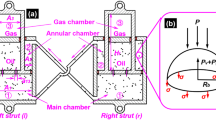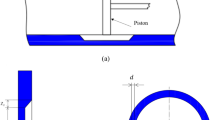Abstract
Two various mathematical approaches of the pneumatic suspension (PS) are proposed and researched to evaluate the reliability and performance of the mathematical models, advantages-disadvantages, and scope of application of each method on the PS of the vehicles. The experimental study of the PS model is also presented under the different harmonic excitations to further reinforce the reliability of the research results. The investigation results indicate that the accuracy of the mathematical approach I (MA-I) determined based on the lumped parameter of the PS model and the mathematical approach II (MA-II) determined via the mass flow rate of the PS is the same results. Besides, the MA-I can easily determine the initial stiffness and damping parameters of the PS and optimize or control the PS, while the MA-II can easily apply for the multi-airbag suspensions using the parallel and long pipes. Additionally, the MA-I should be used for the multi-axles vehicles of the heavy trucks or semi-trailer trucks using the PS that each PS consists of only one air bag connected with a reservoir to improve the ride comfort and road-friendly, conversely, the MA-II should be applied for the two-axle vehicles equipped with the hydraulically interconnected suspensions to enhance the ride comfort and the lateral/roll stability. The research results not only reinforce the reliability and give the advantages-disadvantages of each MA-I and MA-II but also clarify the effectiveness and scope of application of each method on different vehicles.














Similar content being viewed by others

Abbreviations
- AME:
-
Advanced modeling environment
- MA-I:
-
Mathematical approach I
- MA-II:
-
Mathematical approach I
- MTS:
-
Mechanical testing systems
- RMS:
-
Root mean square
- PSD:
-
Power spectral density
- PS:
-
Pneumatic suspension
- A s :
-
Pipe’s cross-section area/m2
- A e :
-
Air bag’s effective area/m2
- b ir,l :
-
Horizontal distance of suspensions/m
- b air,l :
-
Horizontal distance of wheels/m
- C β z :
-
Nonlinear damping parameter/Ns2 m−2
- C s :
-
Damping coefficient of the pipe/Ns m−1
- d s :
-
Pipe’s diameter/m
- f :
-
Frequency of vibration excitation/Hz
- F :
-
Air bag’s acting force/N
- K x :
-
PS’s nonlinear elastic stiffness/N m−1
- K v z :
-
Air bag’s viscous stiffness/N m−1
- K e z :
-
Air bag’s static stiffness/N m−1
- K tir,l :
-
Stiffness of right/left wheels/N m−1
- l s :
-
Pipe length/m
- l j :
-
Longitudinal distance of vehicles/m
- M d,t,ai :
-
Mass of tractor driver, trailer, axles/kg
- M b,air,l :
-
Mass of car and right/left wheels/kg
- m s :
-
Air mass in pipe/kg
- n :
-
Air’s polytropic constant
- p a :
-
Standard atmospheric pressure/Pa
- p b :
-
Air bag pressure/Pa
- p r :
-
Reservoir pressure/Pa
- p 0 :
-
PS’s initial pressure/Pa
- Q :
-
Mass flow rate of air
- q tir,l :
-
Vibration excitation at right/left wheels/m
- V 0b :
-
Air bag’s initial volume/m3
- V 0r :
-
Reservoir’s initial volume/m3
- V b :
-
Air bag’s volume/m3
- V r :
-
Reservoir's volume/m3
- v :
-
Vehicle moving velocity/m s−1
- z :
-
Air bag’s vertical displacement/m
- Z d,t,ai :
-
Vertical vibration of tractor driver, trailer, axles/m
- Z air,l :
-
Vertical vibrations at right/left car wheels/m
- z(t):
-
Vibration excitation of PS model/m
- Z b :
-
Vertical vibration of car body/m
- φ d,t :
-
Angular vibration of tractor driver, trailer/rad
- θ d,t,ai :
-
Angular vibration of tractor driver, trailer, axles/rad
- φ b :
-
Pitching angle of car body/rad
- θ b :
-
Rolling angle of car body/rad
- δ s :
-
Air displacement in pipe/m
- ρ :
-
Air density/kg m−3
- With the heavy truck model:
-
i = 1 − 3 and j = 1 − 5
- With the car model:
-
i = j = 1 − 2
References
Presthus M (2002) Derivation of air spring model parameters for train simulation [M.S. thesis]. Lulea University of Technology
Nguyen V, Jiao R, Zhang J (2020) Control performance of damping and air spring of heavy truck air suspension system with optimal fuzzy control. J Veh Dyna Stab and NVH 4:179–194
Nguyen V, Zhang J et al (2017) Performance analysis of air suspension system of heavy truck with semi-active fuzzy control. J Southeast Univ 33(2):159–165
Jiao R, Nguyen V (2020) Studies on the low frequency vibration of the suspension system for heavy trucks under different operation conditions. Noise & Vibration Worldwide 52(6):127–136
Chen Y, Ahmadian M, Peterson A (2015) Pneumatically balanced heavy truck air suspensions for improved roll stability. SAE Technical Paper: 2015–01–2749
Nguyen V, Zhang J, Le V et al (2018) Vibration analysis and modeling of an off-Road vibratory roller equipped with three different cab’s isolation mounts. Shock Vib 2018:1–17
Nieto A, Morales A, Trapero J et al (2011) An adaptive pneumatic suspension based on the estimation of the excitation frequency. J Sound Vib 333:1891–1903
Robinson W (2012) A pneumatic semi-active control methodology for vibration control of air spring based suspension systems [Ph.D. thesis]. Iowa State University
Berg M (1999) A Three-dimensional air spring model with friction and orifice damping. Veh Syst Dyn: Int J Veh Mech Mobil 33:528–539
Berg M (1998) A Non-linear rubber spring model for rail vehicle dynamics analysis. Veh Syst Dyn 30:197–212
Nieto A, Morales A, Chicharro J, Pintado P (2010) Unbalanced machinery vibration isolation with a semi-active pneumatic suspension. J Sound Vib 329:3–12
Zhu H, Yang J, Zhang Y, Feng X (2017) A novel air spring dynamic model with pneumatic thermodynamics, effective friction and viscoelastic damping. J Sound Vib 408:87–104
Sayyaadi H, Shokouhi N (2009) New dynamics model for rail vehicles and optimizing air suspension parameters using GA. Trans B: Mech Eng 16:496–512
Zhou H, Nguyen V et al (2021) Performance of the CHPI on improving vibration of vibratory roller cab: experiment and simulation. Noise Vib Worldw 52(3–4):102–112
Yuan H, Nguyen V, Zhou H (2021) Research on semi-active air suspensions of heavy trucks based on a combination of machine learning and optimal fuzzy control. J Veh Dyn Stab NVH 5(2):1–14
Qi H, Zhang N, Chen Y, Tan B (2021) A comprehensive tune of coupled roll and lateral dynamics and parameter sensitivity study for a vehicle fitted with hydraulically interconnected suspension system. Proc Inst Mech Eng Part D: J Auto Eng 235:143–161
Razenberg J (2009) Modelling of the hydro-pneumatic suspension system of a rally truck [M.S. thesis]. Eindhoven University of Technology
Li X, Li T (2013) Research on vertical stiffness of belted air springs. Veh Syst Dyn 51:1655–1673
Zhu H, Yang J, Zhang Y, Feng X, Ma Z (2017) Nonlinear dynamic model of air spring with a damper for vehicle ride comfort. Nonlinear Dyn 89:1545–1568
Chen Y, Peterson W, Ahmadian M (2019) Achieving anti-roll bar effect through air management in commercial vehicle pneumatic suspensions. Veh Syst Dyn 57:1775–1794
Tan B, Wu Y, Zhang N, Zhang B, Chen Y (2019) Improvement of ride quality for patient lying in ambulance with a new hydro-pneumatic suspension. Adv Mech Eng 11:1–20
Wang M, Zhang B, Chen Y et al (2020) Frequency-based modeling of a vehicle fitted with roll-plane hydraulically interconnected suspension for ride comfort and experimental validation. IEEE Access 8:1091–1104
Qi H, Chen Y, Zhang N et al (2020) Improvement of both handling stability and ride comfort of a vehicle via coupled hydraulically interconnected suspension and electronic controlled air spring. Proc Inst Mech Eng Part D: J Auto Eng 234:552–571
ISO 8068 (1995) Mechanical vibration - road surface profiles - reporting of measured data. Geneve, Switzerland, International Organization for Standardization
INTEC GmbH (2005) Documentation to Simpack. Simpack. Version 8.7 Edition
Docquier N, Fisette P, Jeanmart H (2007) Multiphysic modelling of railway vehicles equipped with pneumatic suspensions. Veh Syst Dyn 45:505–524
Nguyen V, Zhang J et al (2019) Low-frequency performance of semi-active cab’s hydraulic mounts of an off-road vibratory roller. Shock Vib 2019:1–15
ISO 2631–1 (1997) Mechanical vibration and shock - Evaluation of human exposure to wholebody vibration - Part 1: general requirements. Geneve, Switzerland, International Organization for Standardization
Acknowledgements
This research is supported by the Open Fund Project of Hubei Key Laboratory of Intelligent Transportation Technology and Device, Hubei Polytechnic University (Nos. 2021XZ107, 2020XZ107), the Key Scientific Research Project of Hubei Polytechnic University (No. 21xjz02A), and the Key Project of Scientific Research Plan of Education Department of Hubei Province (No. D20204501).
Author information
Authors and Affiliations
Corresponding author
Additional information
Technical Editor: Samuel da Silva.
Publisher's Note
Springer Nature remains neutral with regard to jurisdictional claims in published maps and institutional affiliations.
Rights and permissions
About this article
Cite this article
Jiao, R., Nguyen, V., Guo, X. et al. Evaluating the reliability of two mathematical models of the pneumatic suspension via two various theoretical approaches. J Braz. Soc. Mech. Sci. Eng. 43, 482 (2021). https://doi.org/10.1007/s40430-021-03193-0
Received:
Accepted:
Published:
DOI: https://doi.org/10.1007/s40430-021-03193-0



